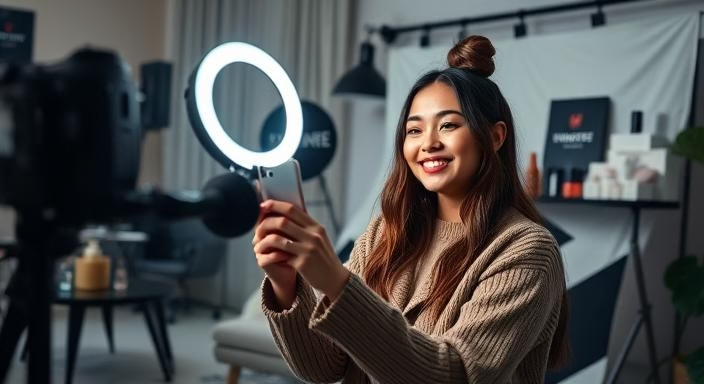Introduction
Brief Overview of the Influencer Phenomenon
In recent years, influencers have become a dominant force in the digital landscape. These individuals, who have amassed large followings on social media platforms such as Instagram, YouTube, and TikTok, hold significant sway over consumer behavior. Their ability to connect with audiences on a personal level allows them to share opinions, promote products, and drive trends in ways that traditional advertising struggles to match.
Importance of Influencers in Modern Marketing and Social Media
The rise of influencer marketing has reshaped the marketing landscape. Brands now partner with influencers to promote their products to highly engaged audiences, often leading to better consumer trust and higher conversion rates compared to traditional advertising methods. Influencers have the ability to craft authentic narratives that resonate deeply with followers, making them more effective than conventional celebrity endorsements. This shift is particularly prominent on social media, where influencers engage with audiences directly and often in real-time.
Purpose of the Article: To Explore the Impact, Challenges, and Future of Influencers
This article aims to dive deeper into the growing influence of these content creators. It will examine the positive impact of influencers on brand awareness, audience engagement, and sales. Additionally, the article will address some of the challenges influencers face, such as maintaining authenticity, managing sponsored content, and navigating the evolving landscape of social media algorithms. Finally, it will explore the future of influencers, considering emerging trends such as virtual influencers, changes in platform dynamics, and shifting consumer preferences in an increasingly digital world.
The Evolution of Influencers
Historical Context: From Celebrities to Everyday Influencers
The concept of influencing isn’t new, but the landscape has significantly shifted over time. Historically, celebrities, such as movie stars and athletes, were the primary figures with the power to influence public opinion and consumer behavior. However, with the rise of social media platforms, a democratization of influence occurred. Ordinary people, with no celebrity status, could now build their own followings through consistent content creation and engagement with niche audiences. This marked the shift from traditional celebrity endorsements to a more accessible and relatable form of influence.
The Role of Social Media Platforms in the Rise of Influencers
Social media platforms like Instagram, YouTube, and TikTok have been the driving forces behind the influencer boom. These platforms provided the tools and opportunities for individuals to share their personal lives, expertise, or creativity with a global audience. Instagram’s visual-centric model encouraged beauty, fashion, and lifestyle influencers, while YouTube paved the way for vloggers, makeup artists, and tech enthusiasts to thrive. TikTok, with its viral short-form videos, introduced a new wave of influencers, particularly younger audiences, leveraging trends and challenges to grow quickly. The algorithms on these platforms further promoted influencer content, ensuring that influencers could gain visibility and build communities.
Key Milestones in the Influencer Industry
Several key milestones have helped shape the influencer industry. One of the earliest was the creation of affiliate marketing programs, allowing influencers to monetize their content through product links. Another significant moment was the rise of influencer management agencies that helped talent navigate brand partnerships. In recent years, we’ve seen the emergence of influencer marketing platforms, which connect brands with influencers more seamlessly. Additionally, the rise of micro and nano influencers (those with smaller but highly engaged audiences) has altered the way brands approach influencer marketing, making it more personalized and targeted.
Types of Influencers
Mega-Influencers vs. Micro-Influencers
The influencer landscape is often divided into categories based on their reach and audience size. Mega-influencers, typically defined as individuals with over a million followers, often come from celebrity backgrounds, such as actors, athletes, or musicians. These influencers can generate massive exposure for brands, but their influence may lack the personal connection that smaller influencers offer. In contrast, micro-influencers, who typically have between 10,000 to 100,000 followers, engage in more niche markets and tend to have a closer, more loyal relationship with their audiences. Micro-influencers offer brands the advantage of higher engagement rates, as their followers often trust their opinions more than those of mega-influencers.
Niche Influencers and Their Impact on Specific Industries (Fashion, Fitness, Tech, etc.)
Niche influencers are those who focus on a specific industry or interest, allowing them to engage with targeted audiences. These influencers often work in areas such as fashion, fitness, beauty, travel, food, or technology, among others. Their ability to cater to a specific audience allows them to drive more meaningful conversations and recommendations. For example, a fitness influencer can sway their followers to purchase workout gear or supplements, while a tech influencer might drive demand for gadgets and electronics. The impact of niche influencers is particularly significant in industries where expert knowledge or authenticity is valued, as their followers often see them as trustworthy authorities within their particular field.
The Rise of Nano-Influencers and Their Growing Relevance
In recent years, nano-influencers—those with fewer than 10,000 followers—have become an increasingly important part of the influencer marketing ecosystem. Despite their smaller reach, nano-influencers often have the most engaged and loyal followers. Their content tends to feel more authentic and personal, which resonates deeply with their audience.
Brands are beginning to recognize the value of nano-influencers for hyper-targeted campaigns, as these influencers tend to generate higher engagement rates and have a unique ability to drive word-of-mouth recommendations within tightly-knit communities. As trust in traditional advertising wanes, the growing relevance of nano-influencers continues to shape how brands approach digital marketing.
The Business of Influencing
How Influencers Monetize Their Platforms (Sponsorships, Affiliate Marketing, Merchandise, etc.)
Influencers have developed various strategies to turn their online presence into a profitable business. One of the most common methods is sponsorships, where brands pay influencers to promote their products or services through posts, stories, or videos. This type of partnership can be highly lucrative, especially for influencers with large or highly engaged followings.
Another popular monetization method is affiliate marketing, where influencers earn a commission for each sale made through their unique referral links. Many influencers also launch their own merchandise, offering branded products like clothing, accessories, or beauty items. This provides a direct revenue stream and allows influencers to capitalize on their personal brand. Additionally, influencers can offer paid content or exclusive subscriptions through platforms like Patreon, where followers pay for premium content.
The Role of Influencer Marketing Agencies
Influencer marketing agencies play a crucial role in managing the business side of influencing. These agencies help brands identify the right influencers for their campaigns, negotiate contracts, and handle logistics. They also assist influencers in managing their partnerships and ensuring that they maintain a steady stream of sponsored content without compromising their authenticity.
By working with an agency, both brands and influencers can streamline their collaboration process and ensure that campaigns are executed effectively. Many agencies also offer services like content creation, social media strategy, and analytics to track the success of influencer-driven campaigns.
Case Studies of Successful Influencer Campaigns
Several successful influencer campaigns highlight the power of effective collaboration. For example, the Gymshark brand has partnered with fitness influencers to create viral workout content, generating massive sales and brand recognition.
The Daniel Wellington watch brand is another notable case, where influencers were given free products in exchange for showcasing them on social media, leading to exponential growth. These campaigns show how the right combination of product, influencer, and audience engagement can result in substantial business success.
The Impact of Influencers
Influence on Consumer Behavior and Purchasing Decisions
Influencers have a profound impact on consumer behavior and purchasing decisions. Their ability to recommend products and services to highly engaged audiences often leads to a direct increase in sales. This power comes from the trust and relatability influencers have cultivated with their followers, who are more likely to act on their recommendations than traditional advertisements.
Influencer endorsements can create a sense of authenticity and exclusivity, leading to an emotional connection that drives purchasing choices. Many consumers today value the opinions of influencers they follow, often considering them as experts or peers, which makes influencer marketing an effective strategy for brands looking to influence buying decisions.
The Role of Influencers in Shaping Trends and Public Opinion
Influencers have become major players in shaping trends and public opinion. Whether it’s the latest fashion trends, viral challenges, or social causes, influencers play a pivotal role in setting the agenda for what is considered “cool” or “relevant.” They have the power to amplify trends rapidly through their platforms, influencing not only consumer habits but also broader cultural shifts.
For instance, influencers in the fashion and beauty industries often launch new styles or beauty products that quickly become mainstream. Additionally, many influencers use their platform to raise awareness about social or political issues, making them influential voices in shaping public opinion and driving societal change.
Ethical Considerations: Authenticity, Transparency, and the Impact on Mental Health
The growing influence of content creators also brings ethical considerations, particularly regarding authenticity and transparency. Influencers are often expected to promote products in an honest and transparent manner, disclosing paid partnerships and sponsored content. However, issues arise when followers feel misled or when influencers promote products that don’t align with their values. Furthermore, the pressure to maintain a perfect online persona can take a toll on mental health, both for influencers and their followers.
The curated images and lifestyles shared online may contribute to unrealistic beauty standards or feelings of inadequacy, highlighting the need for greater accountability in the influencer industry. Ethical marketing practices and self-care for influencers have become central conversations in the growing world of social media influence.
Challenges Faced by Influencers
The Pressure to Maintain a Perfect Image
One of the most significant challenges influencers face is the pressure to maintain a perfect image. Social media platforms are often curated spaces where influencers are expected to present an idealized version of their lives, bodies, and careers. This constant pursuit of perfection can lead to burnout, anxiety, and dissatisfaction. Influencers frequently feel the need to project flawless appearances and lifestyles, which may not reflect their real-life experiences.
This can foster feelings of inadequacy among their followers, as they compare their own lives to the curated images influencers share. Additionally, influencers may feel trapped by the need to live up to the expectations of their audience, which can negatively impact their mental health and creativity.
Dealing with Negative Feedback and Online Harassment
Another challenge influencers often face is dealing with negative feedback and online harassment. As public figures, they are open to scrutiny, which can range from mild criticism to hateful comments and cyberbullying. Negative feedback can be especially harmful when it is targeted at personal attributes or perceived flaws. Influencers, particularly those with large followings, may experience frequent attacks on their appearance, personality, or opinions.
Handling these comments can be emotionally draining and challenging, and it can sometimes lead to self-doubt or a desire to step away from the public eye. The rise of cancel culture and online trolling has made this an even more prevalent issue for influencers across all industries.
The Impact of Algorithm Changes on Visibility and Engagement
The frequent algorithm changes on platforms like Instagram, YouTube, and TikTok also pose a significant challenge for influencers. Social media algorithms are constantly evolving, and these shifts can drastically impact an influencer’s visibility and engagement. What worked to gain traction in the past may no longer be effective due to changes in how platforms prioritize content.
As a result, influencers may find it harder to reach their audience, even if their content remains high-quality. This unpredictability can make it difficult for influencers to maintain a steady flow of content and engagement, forcing them to constantly adapt and alter their strategies to stay relevant and visible.
The Future of Influencers
Emerging Trends in Influencer Marketing (e.g., Virtual Influencers, AI-Driven Content)
The future of influencer marketing is likely to be shaped by emerging trends that leverage cutting-edge technology. One such trend is the rise of virtual influencers, digital characters created through 3D modeling and artificial intelligence (AI). These influencers, like Lil Miquela, are gaining popularity for their ability to engage audiences with perfectly crafted personas, often blurring the lines between reality and virtuality. Additionally, AI-driven content is revolutionizing how influencers create posts, with tools that assist in generating personalized content and automating tasks like editing or captions. This trend could make influencer marketing more efficient, scalable, and data-driven, as AI algorithms can predict what types of content resonate best with different audiences.
The Potential Impact of New Technologies (AR, VR) on Influencer Content
The integration of augmented reality (AR) and virtual reality (VR) is set to dramatically alter the landscape of influencer content. AR technology allows influencers to integrate virtual elements into their real-world environment, enhancing product demonstrations or creating interactive experiences for their followers. For example, beauty influencers can use AR filters to showcase makeup products, offering followers a virtual try-on experience.
On the other hand, VR could create fully immersive environments where influencers host virtual events, fashion shows, or interactive brand activations, creating new opportunities for audience engagement. These technologies could bring about more dynamic and engaging content, enabling influencers to push the boundaries of creativity and offering their followers unprecedented levels of interaction.
Predictions for the Future of the Influencer Industry
Looking ahead, the future of the influencer industry will likely see a shift toward even more niche audiences and personalized content. With the increasing saturation of social media, influencers may focus on creating tighter-knit communities around specific interests or causes, allowing for deeper engagement with their followers. Additionally, the use of data analytics will become more refined, with influencers utilizing detailed insights to tailor their content to the precise preferences of their audience.
The growing demand for authenticity and transparency will also continue to shape the industry, with influencers facing increased pressure to maintain trustworthiness in an increasingly commercialized space. As new technologies and platforms emerge, the influencer industry will continue to evolve, creating new opportunities and challenges for both influencers and brands.
Conclusion
Recap of the Key Points Discussed
Throughout this article, we have explored the evolution of influencers, from traditional celebrities to the rise of everyday influencers who use social media platforms like Instagram, YouTube, and TikTok to build powerful personal brands. We delved into the business of influencing, highlighting how influencers monetize their platforms through sponsorships, affiliate marketing, and merchandise, while also discussing the role of influencer marketing agencies. The article also examined the impact of influencers, both on consumer behavior and the shaping of public opinion, alongside the ethical considerations surrounding authenticity, transparency, and mental health. We also touched on the challenges influencers face, including maintaining a perfect image, dealing with online harassment, and navigating algorithm changes that affect visibility.
The Enduring Relevance of Influencers in the Digital Age
Despite the rapid changes in the digital landscape, influencers continue to hold significant power in shaping consumer behavior and cultural trends. The enduring relevance of influencers in today’s digital age is evident, as they have become integral to brand marketing strategies, social movements, and online communities. As trust in traditional advertising continues to decline, influencers have emerged as more credible and relatable figures who bridge the gap between brands and consumers. Their ability to engage and inspire action ensures that they will remain central to digital marketing and communication in the years to come.
Final Thoughts on the Evolving Role of Influencers in Society
The role of influencers is evolving alongside technological advancements, shifting societal norms, and changes in consumer expectations. With emerging trends such as virtual influencers and AI-driven content, influencers are exploring new ways to connect with their audiences. Their influence extends beyond consumerism, as many are now shaping social, political, and cultural dialogues. As their impact grows, influencers will likely play an increasingly critical role in both the digital and physical worlds, contributing to the ongoing transformation of society.
FAQs
What is influencer marketing?
Influencer marketing involves collaborating with individuals who have established credibility and a substantial following on social media platforms. These influencers promote products or services to their audience, leveraging their trust and reach to drive consumer behavior.
How do influencers monetize their platforms?
Influencers generate income through various channels, including sponsored content, affiliate marketing, merchandise sales, and paid partnerships. They may also earn revenue from advertising on platforms like YouTube or through brand collaborations.
What are virtual influencers?
Virtual influencers are computer-generated characters designed to resemble real people. They engage audiences on social media, promoting products and services, and have become a notable trend in digital marketing.
How do algorithm changes affect influencer visibility?
Social media platforms frequently update their algorithms, impacting how content is displayed to users. These changes can affect an influencer’s reach and engagement, as content may be shown to a different audience or less frequently.
What ethical considerations are associated with influencer marketing?
Ethical concerns in influencer marketing include ensuring authenticity, maintaining transparency about sponsored content, and addressing the potential impact on mental health due to unrealistic portrayals on social media.citeturn0search7 navlistInfluencers Investing in Luxury Properties
Stay Updated with USASTIR



